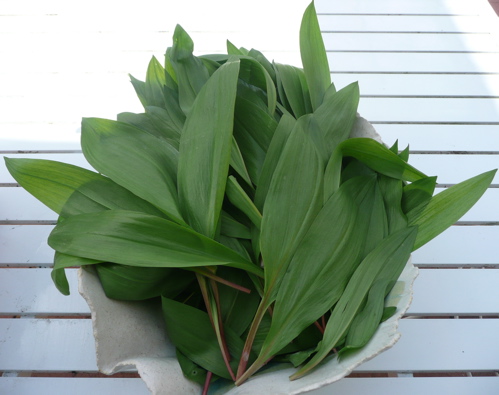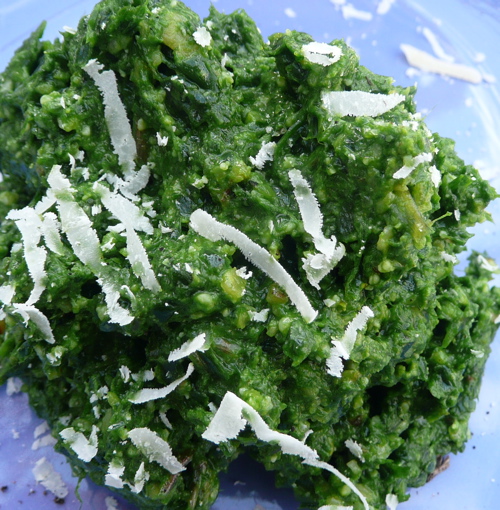Ramp Pesto
I bumped into two fellow foragers gathering ramps two miles from my house. Even from my car, I could see the woods were lousy with ramps as well as the red flowers topping endangered trillium. So I scissored a large bowlful of ramp leaves, leaving their roots to regenerate next year’s crop, but also because I prefer the greens solo in ramp pesto.
A tad spicy and bright green with a slight edge of the wild, slighty textured ramp pesto has become a forager’s classic. It’s extremely versatile, and freezes well in ice cube trays for later use, which is a good thing, because I’m just out of last season’s tomatillo salsa. Makes about 2-1/4 cups (serving suggestions below)
2 handfuls local nuts, walnuts or pecans halves or blanched almonds
2-1/2 ounces Parmesan or similar cheese
2 very generous handfuls of ramp leaves
About 1/3 cup of olive oil
About 1/4 teaspoons kosher or sea salt, or to taste
1-Toast the nuts in a dry skillet, over medium heat, shaking the pan frequently, until lightly aromatic. (Bend over them and take a whiff. They should smell toasted.) Don’t go too far, as nuts burn easily. Pulse in a food processor until well chopped but not blended. Set aside in a bowl.
2-Throw the cheese into the food processor. Pulse until it is finely chopped. (If the cheese is already grated, skip this step.) Add to the nuts.
3-Puree the leaves together with the oil, stopping and scraping down the bowl as necessary to combine. (Work in two batches if you have a small food processor.) Add to the bowl and stir to combine with the salt.
Tips: If you can’t forage for ramps, many early farmers markets and hi-brow produce stores sell them. If you can, but live in an area where there are ticks, take a shower and throw your clothes in the wash after your harvest. Lyme disease isn’t fun, but ramps are worth a walk in the woods.
How to identify ramps in the wild
Ramps, which are wild leeks, are easy to identify. Look for them in mixed hardwood forests. The root is scallion-like bulb, topped with two broad green leaves that may be slightly purplish at their base. Before harvesting, crush them to make sure they omit an oniony smell. They often, but not always, grow near Trout Lilies, Blue Cohosh, Dutchman’s Breeches or Squirrel Corn.
Ramp Pesto serving suggestions
You are only limited by your imagination, but here are some ideas. Add a dollop of ramp pesto to vegetable or potato based soup. Spread on a sandwich or wrap. Toss to taste on warm pasta, adding a little water, oil or melted butter, as needed, to thin it. Drizzle the thinned pesto (or spread it) on grilled meat, fish, chicken or vegetables. Stir a little into a local goat fresh cheese or dairy-based dip. Spread on toasted French bread rounds then top with sautéed shiitakes.
What else can you do with ramps?
Pickle for sandwiches. Sliver the leaves into omelettes or throw them into a risotto at the last minute. Layer them into Pommes Anna, a rich potato dish. Pull them up by their roots and smoke them on your grill with a touch of olive oil and salt, adding foil under them to stop them from falling in. Serve as a Vichyssoise, using the ramps instead of cultivated leeks. (Cook the bulbs with the potatoes, then add the chopped leaves towards the end of cooking.)
 Ramps in the wild Please don’t ever over harvest!
Ramps in the wild Please don’t ever over harvest!
We need to leave some for the next generation.
Cleaned ramps with their roots








